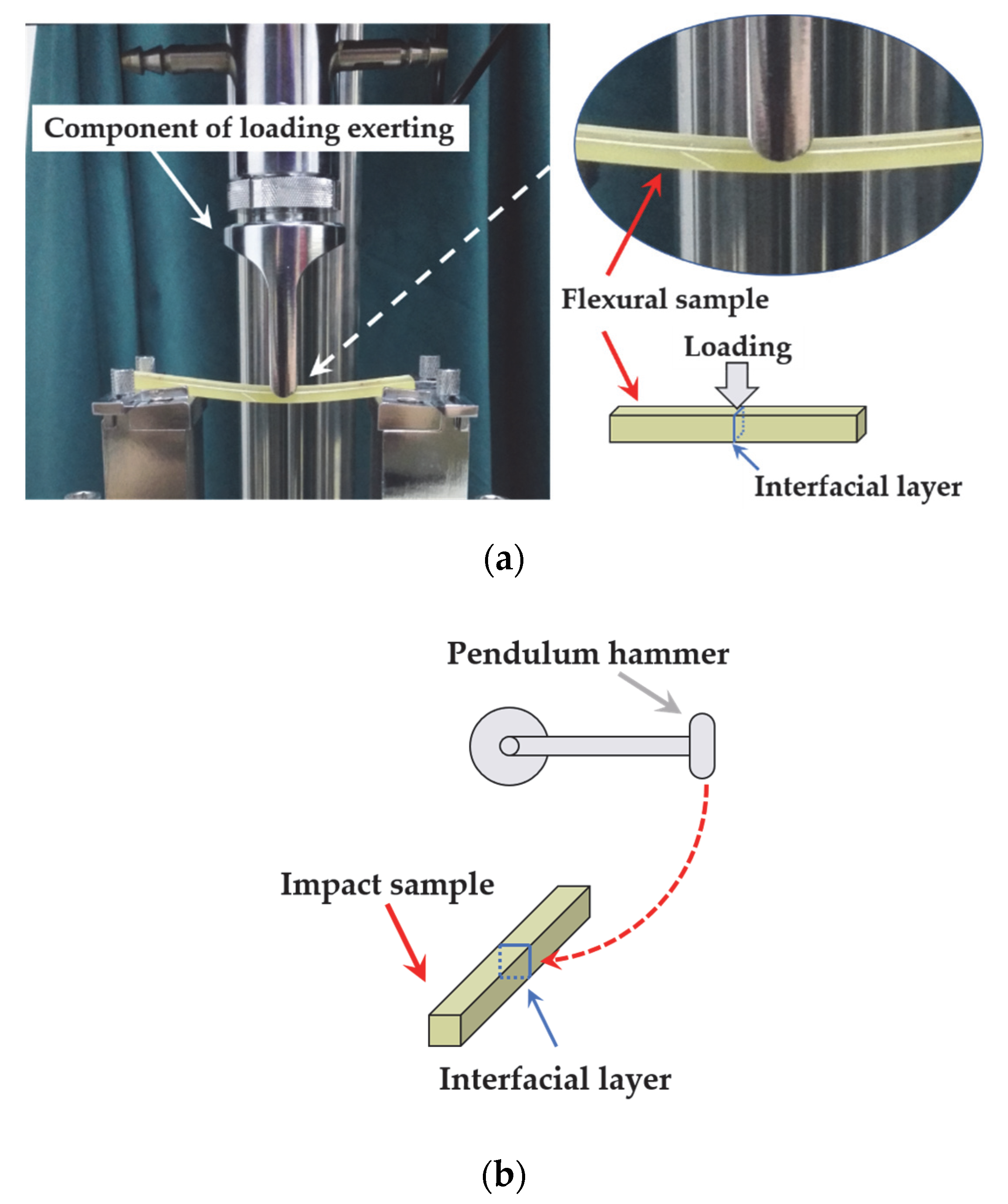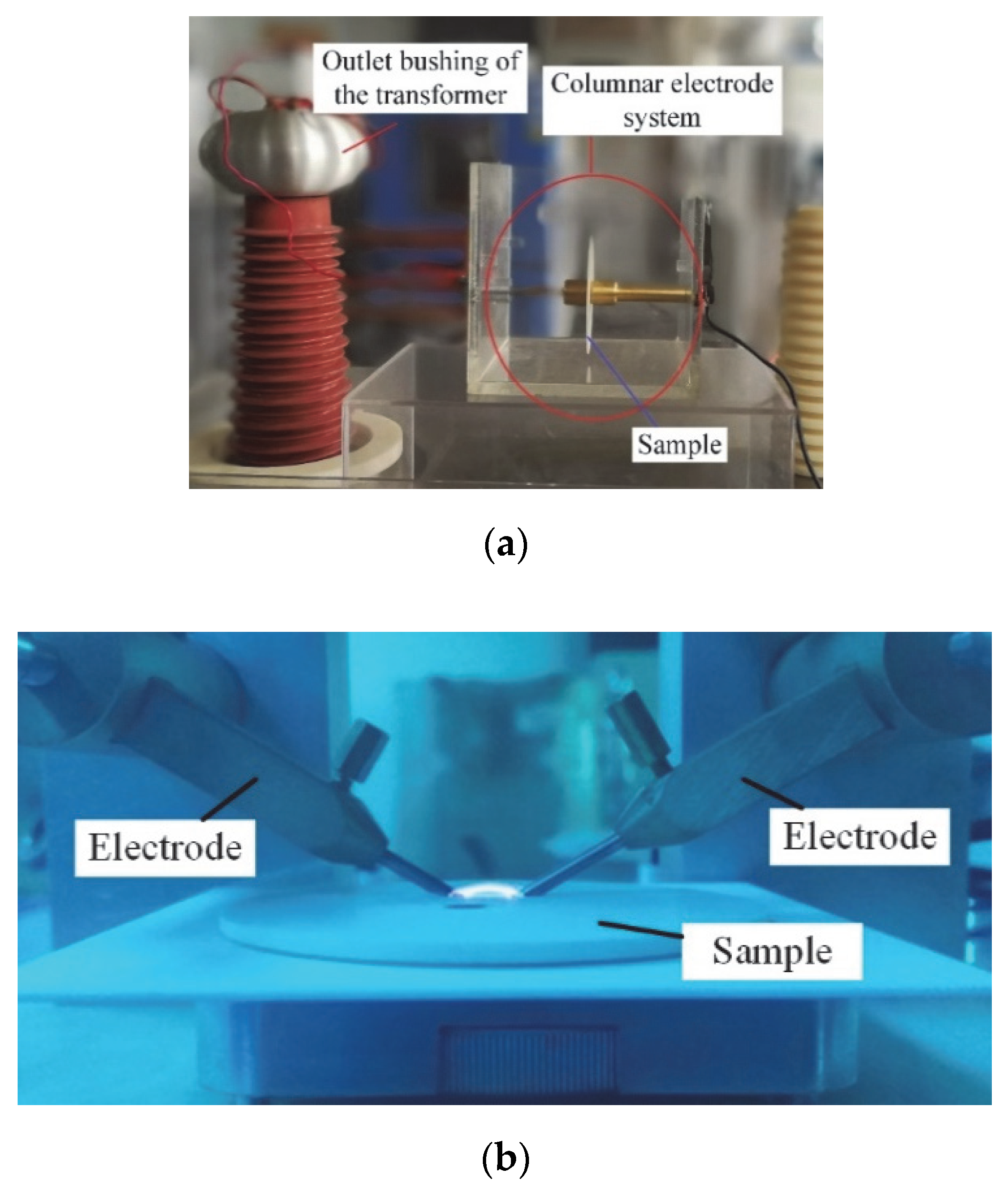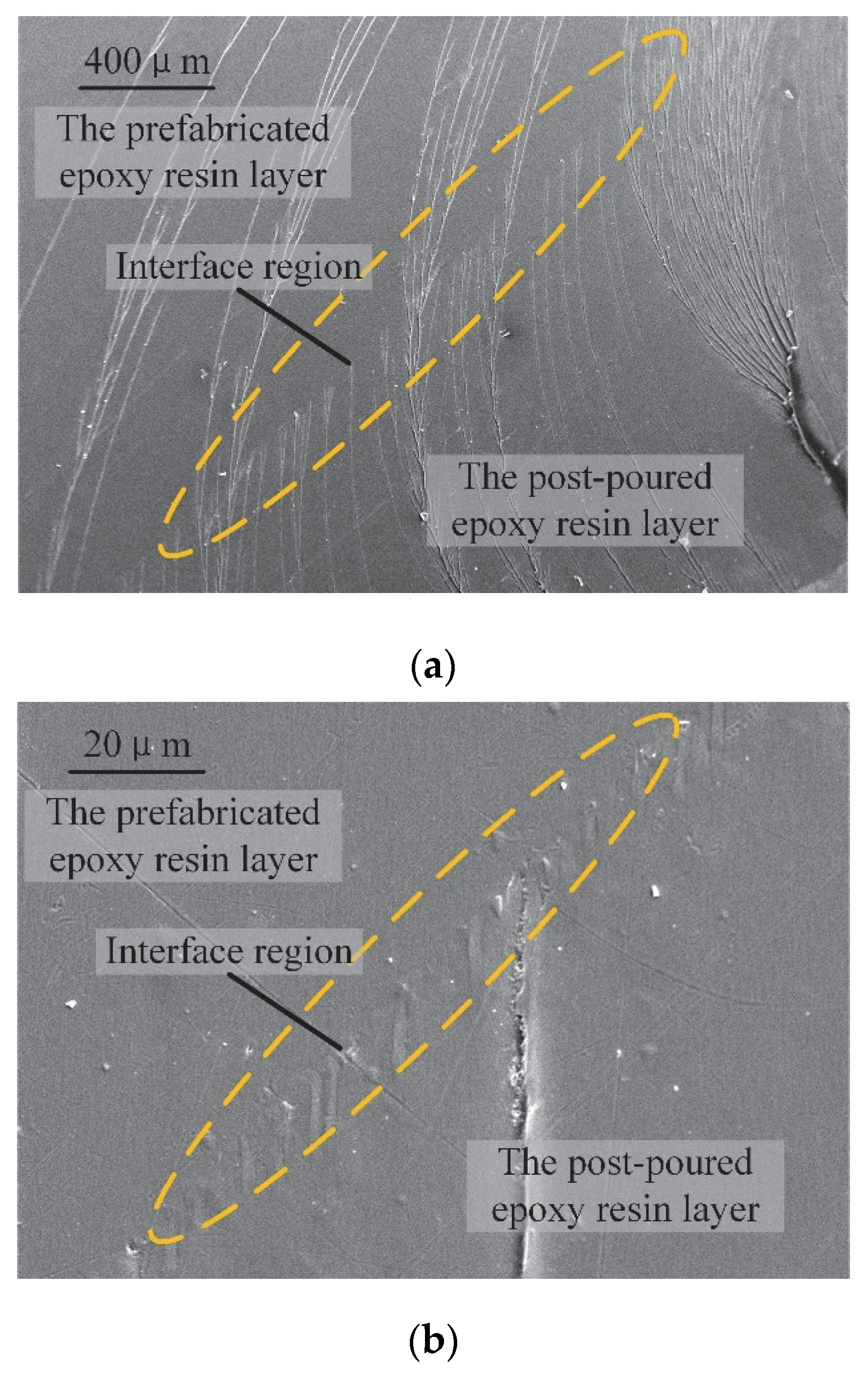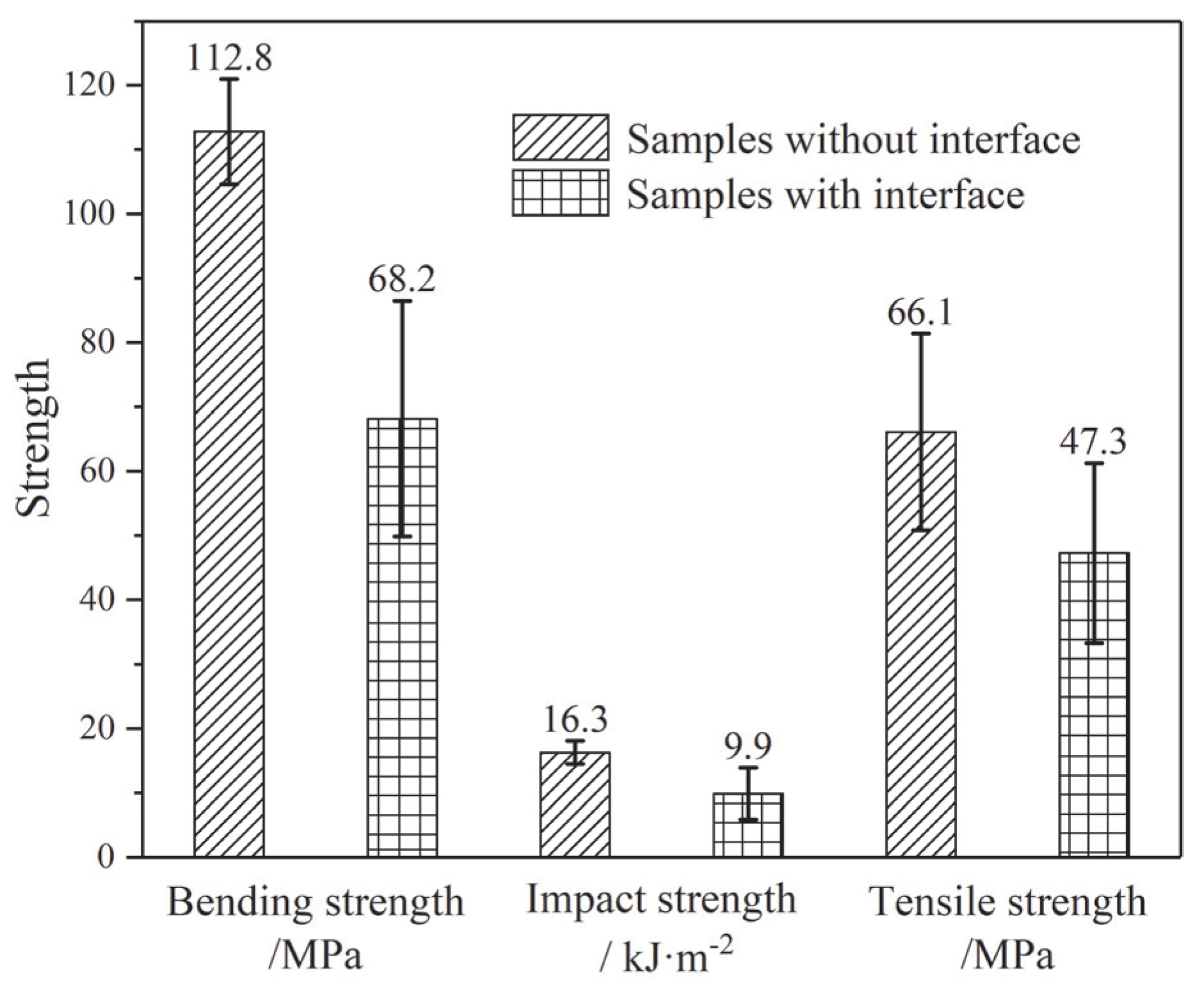Mechanical and Dielectric Strength of Laminated Epoxy Dielectric Graded Materials
Abstract
1. Introduction
2. Sample Preparation and Experimental Methodology
2.1. Materials
2.2. Instruments and Characterization
2.3. Sample Preparation
2.3.1. Curing Process of Epoxy Resin
2.3.2. Preparation of Sample for Mechanical Test
2.3.3. Preparation of Sample for Dielectric Measurement
3. Results and Discussion
3.1. Microstructure Analysis of the Interlaminar Interface
3.2. Mechanical Strength
3.3. Dielectric Strength
3.3.1. AC Breakdown Strength
3.3.2. Arc Ablation Resistance
4. Conclusions
Author Contributions
Funding
Conflicts of Interest
References
- Kim, Y.H.; Lee, H.; Lee, O.; Kim, J.; Bang, S.; Kang, J.O.; Hong, J.; Nam, S.; Ko, T.K.; Kang, H. Dielectric characteristics of solid insulation materials with respect to surface roughness. IEEE Trans. Appl. Supercond. 2015, 25, 1–4. [Google Scholar] [CrossRef]
- Rehman, H. Experimental performance evaluation of solid concrete and dry insulation materials for passive buildings in hot and humid climatic conditions. Appl. Energy 2017, 185, 1585–1594. [Google Scholar] [CrossRef]
- Hong, J.; Heo, J.I.; Nam, S.; Kang, H. Study on the dielectric characteristics of gaseous, liquid, and solid insulation materials for a high voltage superconducting apparatus. IEEE Trans. Appl. Supercond. 2013, 23, 7700604. [Google Scholar] [CrossRef]
- Li, H.; Liu, F.; Tian, H.; Wang, C.; Guo, Z.; Liu, P.; Peng, Z.; Wang, Q. Synergetic enhancement of mechanical and electrical strength in epoxy/silica nanocomposites via chemically-bonded interface. Compos. Sci. Technol. 2018, 167, 539–546. [Google Scholar] [CrossRef]
- Lin, S.; Huang, Y.; Xie, D.; Li, Z.; Min, D.; Yu, S.; Li, S. Dielectric relaxation and carrier transport in epoxy resin. IEEE Inter. Conf. Dielectr. 2016, 2, 1167–1170. [Google Scholar]
- Dong, J.; Wu, K.; Shao, Z.; Su, R. Space charge accumulation in epoxy resin and its nanocomposites under temperature gradient. In Proceedings of the IEEE Conference on Electrical Insulation and Dielectric Phenomena, Ann Arbor, MI, USA, 18–21 October 2015; pp. 443–446. [Google Scholar]
- Naidu, Y.; Nagesh Kumar, G. Minimisation of electric field stress at triple junction of a functionally graded cone type spacer in a gas insulated busduct with metal inserts. High Volt. 2017, 2, 110–118. [Google Scholar] [CrossRef]
- Han, P.; Zha, J.W.; Wang, S.J.; Dang, Z.M. Theoretical analysis and application of polymer-matrix field grading materials in HVDC cable terminals. High Volt. 2017, 2, 39–46. [Google Scholar] [CrossRef]
- Kurimoto, M.; Kato, K.; Hanai, M.; Hoshina, Y.; Takei, M.; Okubo, H. Application of functionally graded material for reducing electric field on electrode and spacer interface. IEEE Trans. Dielectr. Electr. Insul. 2010, 17, 256–263. [Google Scholar] [CrossRef]
- Li, W.D.; You, X.Y.; Mu, H.B.; Deng, J.B.; Zhang, G.J. Numerical optimization and 3D-printing fabrication concept of high voltage FGM insulator. In Proceedings of the IEEE PES Asia-Pacific Power and Energy Engineering Conference, Brisbane, QLD, Australia, 15–18 November 2015. [Google Scholar]
- Kurimoto, M.; Yamashita, Y.; Ozaki, H.; Kato, T.; Funabashi, T.; Suzuoki, Y. 3D printing of conical insulating spacer using alumina/UV-cured-resin composite. In Proceedings of the IEEE Conference on Electrical Insulation and Dielectric Phenomena, Ann Arbor, MI, USA, 18–21 October 2015; pp. 463–466. [Google Scholar]
- Udupa, G.; Rao, S.; Gangadharan, K. Functionally graded composite materials: An overview. Procedia Mater. Sci. 2014, 5, 1291–1299. [Google Scholar] [CrossRef]
- Naebe, M.; Shirvanimoghaddam, K. Functionally graded materials: A review of fabrication and properties. Appl. Mater. Today 2016, 5, 223–245. [Google Scholar] [CrossRef]
- Gupta, A.; Talha, M. Recent development in modeling and analysis of functionally graded materials and structures. Prog. Aeronaut. Sci. 2015, 79, 1–14. [Google Scholar] [CrossRef]
- Liu, X.Q.; Wang, Y.; Zhu, J. Epoxy resin/polyurethane functionally graded material prepared by microwave irradiation. J. Appl. Polym. Sci. 2004, 94, 994–999. [Google Scholar] [CrossRef]
- Li, X.R.; Liu, Z.; Li, W.D.; Sun, G.Y.; Xue, J.Y.; Wang, C.; Zhang, G.J. 3D printing fabrication of conductivity non-uniform insulator for surface flashover mitigation. IEEE Trans. Dielectr. Electr. Insul. 2019, 26, 1172–1180. [Google Scholar] [CrossRef]
- Wang, Q.; Liao, J.; Tian, H.; Liu, P.; Peng, Z. Regularity analysis of the temperature distribution of epoxy impregnated paper converter transformer bushings. IEEE Trans. Dielectr. Electr. Insul. 2017, 24, 3254–3264. [Google Scholar] [CrossRef]
- Guo, Z.; Wang, H.; Wang, C.; Li, H.; Liu, L.; Peng, Z. Calculation and experimental study on the distribution of stress and strain on UHV GIS spacer. In Proceedings of the IEEE International Conference on High Voltage Engineering and Application, Chengdu, China, 19–22 September 2016; pp. 1–4. [Google Scholar]
- Bahadoorsingh, S.; Giussani, R.; Rowland, S. The influence of interfaces and channels on electrical tree growth in epoxy resin. In Proceedings of the Annual Report Conference on Electrical Insulation and Dielectic Phenomena, West Lafayette, IN, USA, 17–20 October 2010; pp. 1–4. [Google Scholar]
- Manping, L.; Kai, W.; Zhanping, Y.; Man, D.; Xin, L.; Yonghong, C. Study on the pulsed flashover characteristics of solid-solid interface in electrical devices poured by epoxy resin. Plasma Sci. Technol. 2014, 16, 856–860. [Google Scholar]
- Chen, G.; Tanaka, Y.; Takada, T.; Zhong, L. Effect of polyethylene interface on space charge formation. IEEE Trans. Dielectr. Electr. Insul. 2004, 11, 113–121. [Google Scholar] [CrossRef]
- Wu, K.; Cheng, C. Interface charges between insulating materials. IEEE Trans. Dielectr. Electr. Insul. 2017, 24, 2633–2642. [Google Scholar] [CrossRef]
- Das, S.; Gupta, N. Interfacial charge behaviour at dielectric—Dielectric interfaces. IEEE Trans. Dielectr. Electr. Insul. 2014, 21, 1302–1311. [Google Scholar] [CrossRef]
- Vu, T.T.; Teyssedre, G.; Vissouvanadin, B.; Le Roy, S.; Laurent, C. Correlating conductivity and space charge measurements in multi-dielectrics under various electrical and thermal stresses. IEEE Trans. Dielectr. Electr. Insul. 2015, 22, 117–127. [Google Scholar] [CrossRef]
- Suh, K.S.; Nam, J.H.; Kim, J.H.; Ko, K.C.; Han, S.O. Interfacial properties of XLPE/EPDM laminates. IEEE Trans. Dielectr. Electr. Insul. 2000, 7, 216–221. [Google Scholar] [CrossRef]
- Meziani, M.; Mekhaldi, A.; Teguar, M. Effect of space charge layers on the electric field enhancement at the physical interfaces in power cable insulation. IEEE Trans. Dielectr. Electr. Insul. 2016, 23, 3725–3733. [Google Scholar] [CrossRef]
- Yi, S.; Wang, Y.; Li, W.; Wu, J.; Yin, Y. Research on the Polarization Relaxation Current and Equivalent Circuit of Double-layered XLPE/EPDM. In Proceedings of the International Symposium on Electrical Insulating Materials (ISEIM), Toyohashi, Japan, 11–15 September 2017; pp. 3277–3330. [Google Scholar]
- Bechstedt, F. Principles of Surface Physics; Springer: Berlin, Germany, 2003. [Google Scholar]
- Li, N.; Tian, J.H.; Deng, W.; Sun, H.G. Application of functionally graded materials for solid insulator: Fabrication, optimization design, and surface flashover of prototype samples. Appl. Mech. Mater. 2013, 291, 2308–2312. [Google Scholar] [CrossRef]
- Fabiani, D.; Simoni, L. Discussion on application of the Weibull distribution to electrical breakdown of insulating materials. IEEE Trans. Dielectr. Electr. Insul. 2005, 12, 11–16. [Google Scholar] [CrossRef]
- Zhou, F.; Li, J.; Yan, Z.; Zhang, X.; Yang, Y.; Liu, M.; Min, D.; Li, S. Investigation of charge trapping and detrapping dynamics in LDPE, HDPE and XLPE. IEEE Trans. Dielectr. Electr. Insul. 2016, 23, 3742–3751. [Google Scholar] [CrossRef]
- Li, S.; Zhu, Y.; Min, D.; Chen, G. Space charge modulated electrical breakdown. Sci. Rep. 2016, 6, 32588. [Google Scholar] [CrossRef]
- Bradwell, A.; Cooper, R.; Varlow, B. Conduction in polythene with strong electric fields and the effect of prestressing on the electric strength. Proc. Inst. Electr. Eng. 1971, 118, 247–254. [Google Scholar] [CrossRef]
- Zhou, C.; Chen, G. Space charge behaviours in polyethylene under combined AC and DC electric fields. In Proceedings of the IEEE Conference on Electrical Insulation and Dielectric Phenomena, Des Moines, IA, USA, 19–22 October 2014; pp. 848–851. [Google Scholar]
- Zhang, Z.; Qiao, X.; Zhang, Y.; Tian, L.; Zhang, D.; Jiang, X. AC flashover performance of different shed configurations of composite insulators under fan-shaped non-uniform pollution. High Volt. 2018, 3, 199–206. [Google Scholar] [CrossRef]










| Stage | Current (mA) | Cycle Time (s) | Total Time (s) |
|---|---|---|---|
| 1/8 | 10 | 1/8 on, 7/8 off | 60 |
| 1/4 | 10 | 1/4 on, 3/4 off | 120 |
| Sample Type | Sample Characteristics | Sample Name |
|---|---|---|
| Prefabricated layer | Samples underwent two-step curing processes | T-sample |
| Samples with interface | Samples with an interlaminar interface | I-sample |
| Post-curing layer | Sample underwent one-step curing process | O-sample |
| Sample Type | Scale Parameter α (kV·mm−1) | Shape Parameter β |
|---|---|---|
| T-sample | 29.76 | 22.06 |
| I-sample | 33.75 | 22.25 |
| O-sample | 31.64 | 13.46 |
| Sample Type | Scale Parameter α (kV·mm−1) | Shape Parameter β |
|---|---|---|
| T-sample | 104.3 | 14.1 |
| Along the interface | 104.3 | 12.3 |
| Cross the interface | 108.7 | 10.1 |
| O-sample | 103.4 | 11.1 |
© 2020 by the authors. Licensee MDPI, Basel, Switzerland. This article is an open access article distributed under the terms and conditions of the Creative Commons Attribution (CC BY) license (http://creativecommons.org/licenses/by/4.0/).
Share and Cite
Wang, C.; Sun, Q.; Zhao, L.; Jia, J.; Yao, L.; Peng, Z. Mechanical and Dielectric Strength of Laminated Epoxy Dielectric Graded Materials. Polymers 2020, 12, 622. https://doi.org/10.3390/polym12030622
Wang C, Sun Q, Zhao L, Jia J, Yao L, Peng Z. Mechanical and Dielectric Strength of Laminated Epoxy Dielectric Graded Materials. Polymers. 2020; 12(3):622. https://doi.org/10.3390/polym12030622
Chicago/Turabian StyleWang, Chuang, Qing Sun, Lang Zhao, Jing Jia, Lixiao Yao, and Zongren Peng. 2020. "Mechanical and Dielectric Strength of Laminated Epoxy Dielectric Graded Materials" Polymers 12, no. 3: 622. https://doi.org/10.3390/polym12030622
APA StyleWang, C., Sun, Q., Zhao, L., Jia, J., Yao, L., & Peng, Z. (2020). Mechanical and Dielectric Strength of Laminated Epoxy Dielectric Graded Materials. Polymers, 12(3), 622. https://doi.org/10.3390/polym12030622






